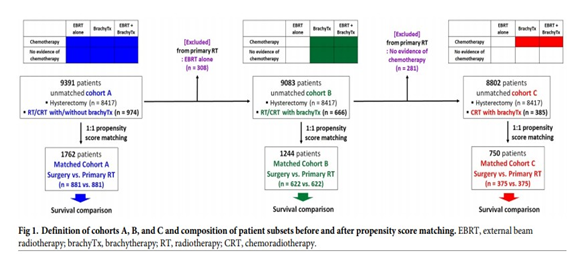글로벌 연구동향
방사선종양학
- [PLoS One.] Optimal use of radiotherapy in the definitive treatment of non-bulky IB-IIA cervical cancer: A population-based long-term survival analysis.
경희의대 / 임유진*
- 출처
- PLoS One.
- 등재일
- 2021 Jun 24
- 저널이슈번호
- 16(6):e0253649. doi: 10.1371/journal.pone.0253649. eCollection 2021.
- 내용
Abstract
Purpose: Although current clinical guidelines recommend surgery or radiotherapy for non-bulky IB-IIA cervical cancer, clinical data supporting the curative role of radiotherapy in the early-stage disease are insufficient. We evaluated the prognostic implications of definitive radiotherapy and determined its optimal use in clinical practice.Methods: Patients with non-bulky (<4 cm) IB-IIA cervical cancer who underwent hysterectomy or primary radiotherapy between 1988 and 2015 were identified from the Surveillance, Epidemiology, and End Results database. Based on the use of brachytherapy and/or chemotherapy, the primary radiotherapy group was classified into three cohorts: hysterectomy vs. radiotherapy overall, with/without brachytherapy and/or chemotherapy (cohort A); radiotherapy and brachytherapy with/without chemotherapy (patients with external beam radiation alone were excluded, cohort B); radiotherapy with brachytherapy and chemotherapy (patients who did not receive chemotherapy were additionally excluded, cohort C). Disease-specific survival (DSS) after hysterectomy was compared to that after primary radiotherapy in each cohort.
Results: Among the 9,391 initially identified patients, 1,762, 1,244, and 750 patients were classified into cohorts A, B, and C, respectively, after propensity score matching. In cohort A, DSS after primary radiotherapy was inferior to that after hysterectomy (P = 0.001). In cohort B, a trend toward differential survival in favor of hysterectomy was observed with marginal significance (P = 0.061). However, in cohort C, DSS after primary radiotherapy was not significantly different to that after hysterectomy (P = 0.127). According to hazard rate function plots, patients receiving external beam radiation alone had an increased short-term risk of disease-specific mortality, whereas patients without evidence of chemotherapy had a distinct late risk surge at approximately 15 years of follow-up.
Conclusion: Optimizing radiotherapy methods with brachytherapy and the use of chemotherapy should be considered for the long-term curative efficacy of primary radiotherapy for non-bulky IB-IIA cervical cancer. Further studies are warranted to corroborate our results.

Affiliations
Yu Jin Lim 1 , Han Na Lee 2
1 Department of Radiation Oncology, Kyung Hee University Medical Center, Kyung Hee University College of Medicine, Seoul, South Korea.
2 Department of Radiology, Kyung Hee University Hospital at Gangdong, Kyung Hee University College of Medicine, Seoul, South Korea.
- 덧글달기









